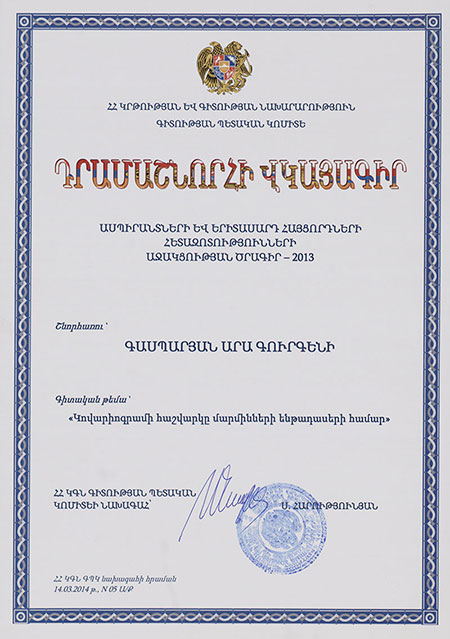The calculation of covariogram for subclasses of bodies
Research Proposal
The theory of convex bodies is a vibrant and classical field of modern mathematics. It has rich applications in various mathematical fields and in many sciences. The principles of the theory of convex bodies were established in the late 19th century by Brunn and Minkowski. Major new results of this theory have been obtained by Aleksandrov and Pogorelov. The concept of covariogram has a great importance for investigation of bounded, convex bodies. The covariogram was introduced by French mathematician Matheron in his book on random sets (see [1]).
Matheron noted, that the covariogram of a bounded, convex domain is a function, that contains a lot of information about the domain and he conjectured that a planar bounded, convex domain is uniquely determined (within the class of bounded, convex domains) by its covariogram (see [2]).
An affirmative answer to the covariogram problem for convex polygons was given by Nagel (see [3]). He proved, that the covariogram determines convex polygons up the translations and refletions in a point within all convex polygones. After various partial results (see [4]) Averkov and Bianchi (see [5]) finally settled the problem completely for arbitrary convex domains in the plane: Every planar bounded, convex domain is determined within all planar bounded, convex domains by its covariogram, up to translations and reflections in a point.
Examples show that convexity is essential in this characterization (see [6]). The authors of [7] present a pair of non-congruent non-convex polygons with equal covariogram. Bianchi (see [8]) found counterexamples to the covariogram conjecture in dimensions greater than or equal to 4, and a positive answer for three-dimensional polytopes (see [9]). The general three-dimensional case is still open.
The covariogram problem appear independently in other contexts. In the setting of probability theory Adler and Pyke (see [10]) asked whether the distribution of the difference X – Y of two independent random points X, Y that are uniformly distributed over D determines D up to translation or reflection.
The investigation of bounded, convex domains is equivalent to investigation of their covariograms. Thus, if we have covariogram for a bounded, convex domain, then we can investigate properties of the bounded, convex domain by the explicit form of the covariogram. Obtaining the explicit form of the covariogram for any bounded, convex domain is a difficult problem, but we can obtain covariograms for subclasses of bounded, convex domains (see [11]). These forms help us to solve many probabilistic problems, in particular, to calculate explicit forms of orientation-dependent chord length distribution function and chord length distribution function, as the concept of covariogram is closely connected with the concept of orientation-dependent chord length distribution function.
The explicit form of covariogram for subclasses of convex bodies allows us to obtain new properties of covariogram and generalized these results we can answer the question what functions will be covariograms of convex bodies, what properties does the covariogram have and what geometric properties can be read in the covariogram. Similar problems have been suggested by Bianchi (see [12]).
One of the scientific goals of the research is to find the explicit form of covariogram for subclasses of bounded, convex domains: Using the explicit form of covariogram and Materon’s formula it is possible to calculate orientation-dependent chord lenght distribution and chord length distribution functions for the corresponding subclasses of bounded, convex domains.
Another scientific goal of the research is to find out does the covariogram of a convex body imply the geometric properties of the body.
REFERENCES
- G. Matheron, “Random Sets and Integral Geometry” (Wiley, New York 1975).
- G. Matheron, “Le covariogramme g\’eometrique des compacts convexes de R”, Technical report 2/86, Centre de G\’eostatistique, Ecole des Mines de Paris, vol. 54, 1986.
- W. Nagel, “Orientation-dependent chord lenght distributions characterize convex polygons” Appl. Prob., 30, no. 3, p. 730-736, 1993.
- G. Averkov and G. Bianchi, “Retriving convex bodies from restricted covariogram functions”, Adv. Appl. Prob., vol. 39, pp. 613-629, 2007.
- G. Bianchi and G. Averkov, “Confirmation of Matheron’s Conjecture on the covariogram of a planar convex body” Journal of the European Mathematical Society 11, 1187-1202, 2009.
- R. J. Gardner, P. Gronche and C. Zong, “Sums, projections and selection of lattice sets and the discrete covariogram”, Discrete Compt. Geom., vol. 34, pp. 391-409, 2005.
- C. Benassi, G. Bianchi and G. D’Ercole, “Covariogram of non-convex sets” University College London, Volume 56, p. 267-284, 2010.
- G. Bianchi, “Matheron’s conjecture for the covariogram problem” J. London Math. Soc. (2), vol. 71, p. 203-220, 2005.
- G. Bianchi, “The covariogram determines three-dimensional convex polytopes”, Advances in Mathematics, 220, pp. 1771–1808, 2009.
- R. J. Adler and R. Pyke, “Scanning Brownian processes’’, Adv. Appl. Prob., vol. 29, pp. 295-326, 1997.
- A. G. Gasparyan and V. K. Ohanyan, “Recognition of triangles by covariogram’’, Journal of Contemporary Mathematical Analysis (Armenian Academy of sciences), vol. 48, no. 3, pp. 110-122, 2013.
- G. Bianchi , “Some known results and open problems related to the covariogram”, Università di Firenze, Cortona, 2011.
Description
I did my research in Yerevan State University from April 2014 to March 2015. During this period I have participated in the seminar "Probabilistic models and stochastic geometry" of Doctor of Physical-Mathematical Sciences Victor Ohanyan where the main aim of the project was deeply reviewed. During the research a necessary condition for orientation-dependent chord length distribution function as a function of maximal chord is obtained and formulated in an article.
